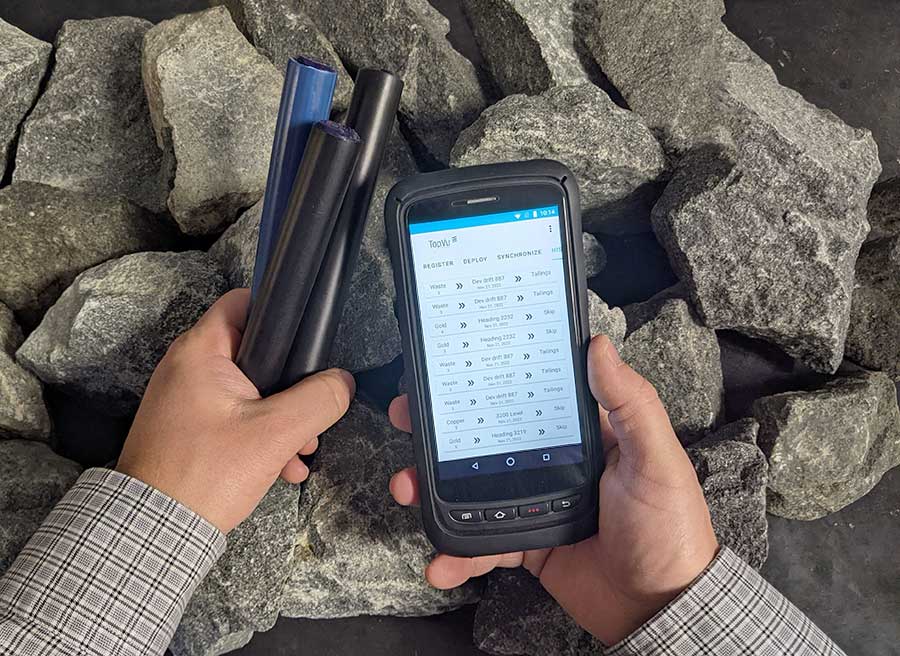Frequently Asked Questions
FAQs on our OTS Ore Tracking System and Ore Tags
Ore Tracking
OTS stands for Ore Tracking System.
TopVu’s OTS is an intelligent tracking system which provides valuable information about material movement from the mine, to the processing plant and beyond. OreTags follow the muck through the mine as it travels the ore circuit, through the primary and secondary crushers. The tags are identified at checkpoints on conveyor belts and/or transfer points along the way. As tags pass through the checkpoints with the ore or waste, their arrival is recorded and stored by the TopVu OTS software. Geologists can check the software at any time to see where and when the ore tags were last detected, and this information can be retrieved and sorted to determine if the muck is on track to its intended destination.
Ore tracking improves grade control, mineral reconciliation management, and alerts managers and geologists when waste is mistakenly sent to the mill. Ore tracking is a mine optimization tool and is often found in mines with various grades of ore where monitoring is required for grade control. The TopVu OTS is used to identify ore and waste streams, confirm origin of material, and identify and transmit mis-shipment alerts. Mill operators and metallurgists use it for pro-active plant control. The OTS software provides real-time alerts about incoming product type, linking the physical properties of the mine to the time-based performance data of the plant.
There are many mining companies around the world using the TopVu OTS, Including Newmont, Vale, Nevada Gold, Agnico Eagle, Teck, Northern Star, Boliden, Evolution, and Sibanye Stillwater.
Every mine has unique challenges and reporting requirements necessary to achieve optimal performance. TopVu’s OTS software was designed for mines by miners. The interface is simple and clear, with live views, sorting tools, historical reports and configurable alerts sent right to a phone or desktop. TopVu’s web-based software allows users to monitor their ore circuit, even from home.
For much of the 20th century, geologists would use colored plastic beads or painted washers to follow their ore to the mill. Some mines still do this. The drawback is geologists must literally see the beads or washers in order to understand the source of the ore. With TopVu’s ore tracking system, tags automatically update the system so no one is required to check in the field.
Some mine geologists track both waste and ore, to gain a deeper understanding of their ore circuit. It can be very costly for a mine when waste is confused with ore, especially when the confusion goes all the way to the plant.
Ore tracking works equally well in both underground and open pit mines. The TopVu OTS performs best with checkpoints positioned on conveyor belts and at ore transfer points in open pit and underground mining operations.
Ore tacking is an optimization tool that mines use to improve operational performance. Tracking material provides information about the mine and the ore circuit that can be used to improve grade control, reconciliation, product supply management, transport logistics and margin management. Teck says the OTS helps them to ‘maximize recovery and maximize yield.’ Geologists in Nevada claim the OTS pays for itself many times over if it helps prevent just one mis-shipment of waste from being processed at the mill.
Ore Tags
The TopVu OTS ore tag is an RFID smart tag. It is black, cylindrical in shape, and measures approximately 2 cm by 17 cm.

Ore tags are usually deployed by hand, after they have been registered and electronically labelled using a mobile or desktop device. They are tossed by geologists onto the muck pile or conveyor belt at the beginning of the muck’s journey out of the mine. They will travel with the muck all the way to its final destination. Tags can also be deployed by TopVu’s auto tag dispenser.
TopVu engineers recommend deploying between three and five tags at a time to get the most accurate representation of the ore circuit flow.
Yes. TopVu OTS tags are extremely durable and are designed to withstand the crushers.
Yes, OTS ore tags are expendable. They have no expiry date and will continue to work until they are completely and totally destroyed.
TopVu RFID tags are effective and relatively inexpensive when compared with alternative technologies.
Active RFID tags require a battery and will stop functioning when the battery dies. Passive RFID tags have no battery and are maintenance free. Passive tags have a range of about 9 unimpeded metres, while active tags can be detected over a greater distance.
TopVu OTS ore tags have been rigorously tested both on and off the mine site and their performance is not affected by moisture.
TopVu customers who have conducted blast resistance tests say yes. They placed tags in bore holes above the stemming and also in parallel ‘dummy’ holes at the face prior to blast. In both instances, a significant number of tags survived and were later detected at checkpoints in the ore circuit.
“The TopVu OTS Gen.2 software allows for app-based real time alerts of mis-shipments. We make sure these alerts are sent to all parties involved, all the way up to operations upper management. Should a large mis-shipment be detected, they have the ability to make the call to shut down the flow of muck. If it’s ore going out as waste, that’s a big catch. We can now recover ounces of gold that would have been completely lost.” Sibanye Stillwater Montana
Read more about their system here.